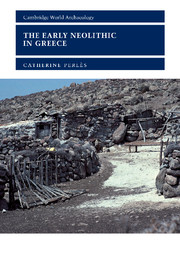Book contents
- Frontmatter
- Contents
- List of figures
- List of tables
- Acknowledgements
- Introduction
- 1 The land and its resources: the geographic context
- 2 The Mesolithic background
- 3 The introduction of farming: local processes, diffusion or colonization?
- 4 Foreign colonists: where from?
- 5 The earliest Neolithic deposits: ‘aceramic’, ‘pre-pottery’ or ‘ceramic’?
- 6 The spread of the Early Neolithic in Greece: chronological and geographical aspects
- 7 A case study in Early Neolithic settlement patterns: eastern Thessaly
- 8 Early Neolithic subsistence economy: the domestic and the wild
- 9 The Early Neolithic village
- 10 Craft specialization: the contrasting cases of chipped-stone tools, pottery and ornaments
- 11 A variety of daily crafts
- 12 Ritual interaction? The miniature world of ‘dolls or deities’
- 13 Interacting with the dead: from the disposal of the body to funerary rituals
- 14 Interactions among the living
- Conclusion
- Bibliography
- Index
11 - A variety of daily crafts
Published online by Cambridge University Press: 18 December 2009
- Frontmatter
- Contents
- List of figures
- List of tables
- Acknowledgements
- Introduction
- 1 The land and its resources: the geographic context
- 2 The Mesolithic background
- 3 The introduction of farming: local processes, diffusion or colonization?
- 4 Foreign colonists: where from?
- 5 The earliest Neolithic deposits: ‘aceramic’, ‘pre-pottery’ or ‘ceramic’?
- 6 The spread of the Early Neolithic in Greece: chronological and geographical aspects
- 7 A case study in Early Neolithic settlement patterns: eastern Thessaly
- 8 Early Neolithic subsistence economy: the domestic and the wild
- 9 The Early Neolithic village
- 10 Craft specialization: the contrasting cases of chipped-stone tools, pottery and ornaments
- 11 A variety of daily crafts
- 12 Ritual interaction? The miniature world of ‘dolls or deities’
- 13 Interacting with the dead: from the disposal of the body to funerary rituals
- 14 Interactions among the living
- Conclusion
- Bibliography
- Index
Summary
The importance given in the previous chapter to flaked-stone tools and pottery should not delude us: especially for the case of chipped-stone tools, it reflects their importance for the prehistorian more than their importance for the prehistoric villager! Functional studies have indeed begun to make clear that many tasks formerly performed with chipped-stone tools, such as wood and skin working, were now performed with implements made from polished stone, bone, or even shell and teeth. These ‘transfers’ within traditional crafts, together with the introduction of new activities, resulted in a complex technological system that was highly sensitive to local idiosyncrasies, traditions and even fashions.
Bone tools, grinding tools, pounding tools, polished celts or the miscellaneous sherd-discs, sling bullets, spools, spindle whorls, and so forth, all classified as ‘small finds’ in traditional excavations, are now just beginning to receive the attention they deserve. Until recently a lack of systematic studies, a reliance on traditional approaches and morphological classifications, and a nearabsence of functional analyses have all drastically limited our understanding of ‘small finds’. These varied artefacts cannot be satisfactorily analyzed either from the point of view of their production or from the point of view of their use. Even the traditional groupings such as ‘bone tools’ or ‘ground stones’ are mostly artificial. They do not correspond to homogeneous categories in terms of manufacturing techniques, nor, necessarily, to functionally related groups of artefacts.
- Type
- Chapter
- Information
- The Early Neolithic in GreeceThe First Farming Communities in Europe, pp. 227 - 254Publisher: Cambridge University PressPrint publication year: 2001



